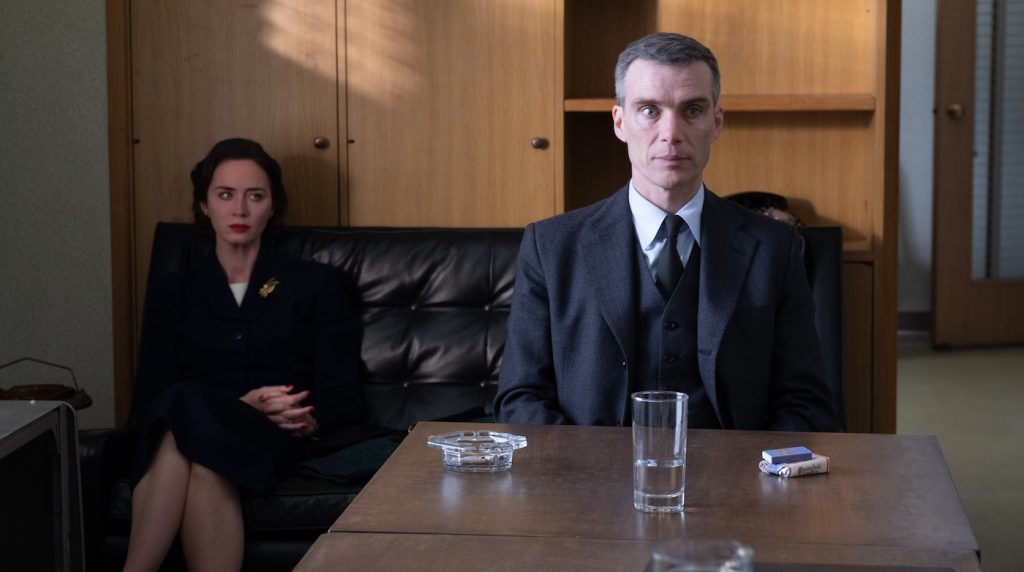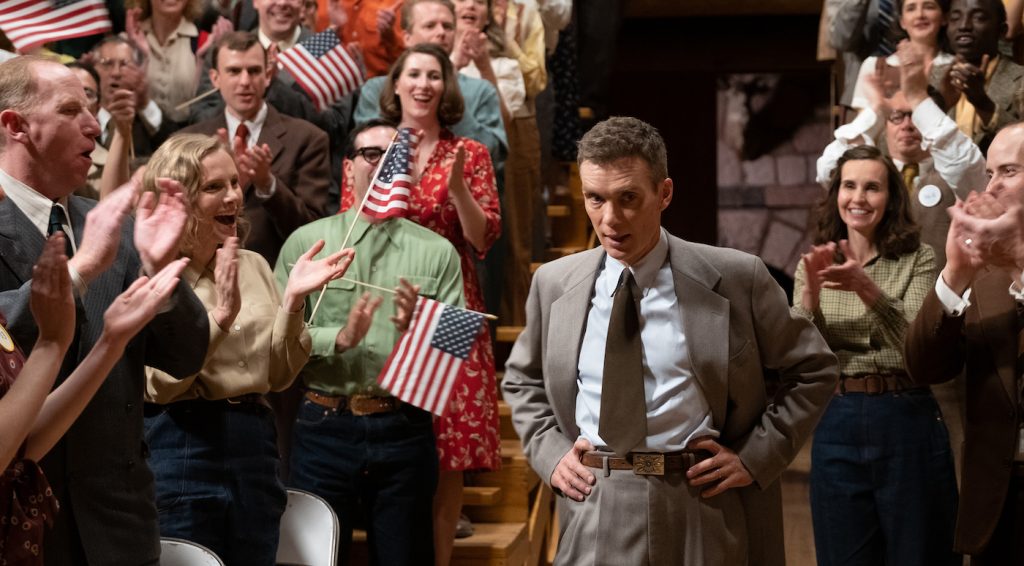Double Oscar Nominee Richard King Unveils the Aural Secrets of “Oppenheimer” and “Maestro”
Richard King, one of Hollywood’s most successful sound designers, is known for creating increasingly complex aural environments that help achieve a director’s vision, giving the movie its own rhythm and texture. Over the past two decades, he’s won four Academy Awards. And at this year’s Oscars, he’s nominated for two more for his contributions to Bradley Cooper’s Leonard Bernstein biopic Maestro and Christopher Nolan’s Oppenheimer, an R-rated historical drama about the first atomic bomb, which means King will be competing against himself for another Best Sound Oscar. Let’s call this one the great “Bernsteinheimer” matchup.
King has collaborated with A-list directors on huge tentpoles, including Steven Spielberg’s War of the Worlds (2005) and Peter Weir’s high-seas adventure Master and Commander (2003), which earned King his first Oscar. With Maestro, which Cooper directed and starred in, King wanted the sound to function like a symphony orchestra, a combination of peacefulness and intensity. Maestro is a look at Bernstein at his peak, as both a composer and conductor (On the Town, Mahler’s “Resurrection” Symphony No. 2), as well as a study of his fatalistic romance with actress Felicia Montealegre (Carey Mulligan). The sound is always with the characters; there is no score, and sometimes, all you hear is a tiny rustle in the trees as they lie in the grass at Tanglewood. There’s no music at all over the scenes where the couple is separated.
Oppenheimer bears a heavier weight, and its sound design can be more visceral and terrifying. The title character is the genius nuclear physicist (Cillian Murphy) overseeing the Manhattan Project. Because writer/director Christopher Nolan wanted to filter the story through the perception of Oppenheimer – a bafflingly complex man who sports a big-brimmed porkpie hat – much of its emotional intensity is expressed through the use of sound. There are aspects of Abstract Expressionism, like when we see Oppenheimer’s vision of a subatomic universe, which King punches up with edgy, staticky noise impressions of dark matter. Then there’s the eerie rhythmic thumping Oppenheimer hears growing louder and more oppressive throughout the film. You could practically feel the floorboards shake.
“The stamping feet is a motif Chris wanted to use several times before the dropping of the bomb,” said King, who works out of Warner Bros. Studios. “It’s a device to convey Oppenheimer’s growing panic about what the creation of this weapon meant to the world.” He and Nolan have done eight movies together, including The Dark Knight (2008), Inception (2010), and Dunkirk (2017), all of which won best sound Oscars.
Even when he’s not sitting at a mixing board, he remains a vigilant listener. “My work has programmed me to keep my ears open,” said King, who studied painting in college and then began his career in New York in low-budget genre films. An early adopter of digital sound technology, he described his work as painting with sound and said he is heavily influenced by Vermeer and Ingres for their heightened reality and the works of de Kooning, Pollack, and Picasso. “The way sound was used in old movies was almost like a stage cue in a play,” said King, whose most recent credit is the critical and commercial smash Dune: Part Two. “It wasn’t possible to get elaborate with the existing technology. But it’s evolved to the point you’re only limited by your imagination.”
The following conversation has been edited and condensed.
Now that you have eight Academy Award nominations, we wonder, when you go to the annual Oscars luncheon, does somebody ask if you want your regular table?
[Laughs] There are people there who have had many more nominations. In fact, my co-nominee, Kevin O’Connell, has 22. He’s the sound mixer on Oppenheimer. But the lunch is fun. It’s the most relaxed of all these events and, for that reason, the most enjoyable.
Okay, seriously, film sound is somewhat of a mystery for people. When members of the sound branch vote, what is it they listen for in movies?
Several things: the shape of the mix from beginning to end, the ebb and flow, the dynamics of the mix, which is invisible to the audience, but you feel it when it’s off-kilter somehow. I think film sound is a mystery because it’s not meant to be noticed by the audience, as much as it is a conduit, a way to draw audiences into the film.
This is a labor-intensive process. How does it work?
The sound recorded on set is maybe 3% of what’s in the film. It’s an important 3% because it contains the dialogue and a lot of sync movement that grounds the picture. But we create the world around that dialogue, all the background sounds and effects, explosions, machinery, and footsteps. They are recorded or created, placed in sync with the picture and layered with other sounds during post-production to create the sonic world the characters inhabit. That’s sound design. All of this takes months of diligent, creative work by the sound team.
What were you trying to accomplish with Maestro?
We attempted to be musical in the presentation of sound. We used rhythm and texture to underscore the characters’ emotions and smooth the transitions. Quite often in films, there’s a distinct sound contrast when you cut from one location or scene to another. You immediately tell the audience, I’m in a different place. With Maestro, all those transitions are seamless. The movie just flows from scene to scene, unrolling like a piece of music.
What did you think the first time you read the script for Oppenheimer, the bulk of which was written in the first person, and what did you circle on the page?
It’s an amazing script, and I loved the way Chris created a kaleidoscopic overview of Oppenheimer’s predicament, the enormous events shaping the world at the time, and his emotional journey through them. After reading it, we had a general conversation before he went off to shoot the film. He wanted me to think about the quantum particle scenes. We were going for unique sounds that convey the power of the objects and events Oppenheimer saw in his imagination. The other thing was how to treat Oppenheimer’s more subjective moments. He was such an enigma. There are moments, though, where you are in his head. You sense his [moral dilemma] about working on the Manhattan Project.
When did you begin coming up with the sounds for Oppenheimer?
Chris invited me to the last day of dailies. They had shot part of the security clearance hearing. It was Oppenheimer in the Gray Commission room when the background behind him starts to vibrate as the lawyer’s yelling in his face, saying he wanted to do this experiment, and yet he regrets having done it. That’s the gist of his dilemma, and Chris wanted to sense him feeling somehow unmoored from the experience, trying to reconcile it. When I saw those images, I started getting ideas about how to deal with his [complicated feelings sonically]. It’s hard for me to respond to words on the page. I need images; that’s just the way my brain works.

Large sections of the movie are split between the Los Alamos desert and a shabby conference room, where the Atomic Energy Commission interrogates Oppenheimer. How did you convey the sense of isolation the team of scientists felt working in secret on the bomb and the claustrophobia of that government hearing?
We gave each location a unique character. The wide-open spaces of New Mexico allowed us to use wind, rain, thunder, and wildlife sounds to accentuate the distances. For instance, placing a bird call or coyote howl far away and adding a lot of reverb. The Gray Commission room is oppressive, without much sense of what’s going on outside. We added a low, airy rumble to add to the oppressiveness.
Take us inside Fuller Lodge, where an excitable crowd has packed into the bleachers to hear Oppenheimer speak about the bomb being dropped in Japan, and we hear the sound of dozens of feet stamping rhythmically.
It’s another scene where his surroundings begin to glitch, a brilliantly executed practical effect that was done in-camera. The shots, to me, convey Oppenheimer’s emotional distress. He doesn’t quite know how to feel about the audience, half of whom are cheering and high-fiving and drinking. It’s a celebration. The other half are weeping and puking. The scene reflects the nightmarish feelings he must have experienced.

You studied painting in school. How did you end up working in sound?
As a kid, I wanted to be in movies. My friends and I would make Super 8 movies with ridiculous plots, sometimes using stop motion. But growing up in Florida, I had zero connection to the film business. It wasn’t until my mid-20s when I moved to New York, and said I’m going to get into this business. One of the doors I knocked on was basically a one-man shop. He made industrial films – the latest sheep dip or cattle worming medicine – documentaries, commercials. He’d let me edit some sequences and give me feedback. He was more interested in shooting than editing. He had pretty much zero interest in the sound. So he gave me a primer on cutting sound effects and music to picture, then said, here’s this film. Why don’t you put sound in it? I worked on a documentary about the building of the dam in South America, so there were lots of explosions and big, Earth-moving equipment, cool 8-year-old boy stuff I could sink my teeth into. I wrote a list of sounds and went to a sound effects house, which meant I sat in a room full of quarter-inch tapes and previewed sounds. Then I made an order list, had them transfer the sounds to 16mm film, picked out music that would be appropriate, brought it all back, and cut it myself. And it was great. A new world opened up to me.
You went on to work for Cannon Films, which became a hot little studio at one point whose specialty was American-style action movies for overseas markets, like Allan Quartermain and the Lost City of Gold.
[Laughs] My first film as a sound supervisor. I’d been a sound editor on one movie, then asked to supervise sound on a movie, and they gave me Allan Quartermain, a massive movie. Richard Chamberlain was in it. It was one of Sharon Stone’s first films. It was an Indiana Jones rip-off. But it was shot in Africa and had these crazy Raiders of the Lost-type predicaments, big set pieces, and action scenes. It was a gold mine of sound opportunities, and at the time, I didn’t have a sound library, so we recorded everything. At that point, I was completely fixed on that route to creating sound for film. The movies I worked on were low-budget, so even getting the story to make sense felt like a magician’s trick. When I edited picture, I found the quality of the footage limited me, but when it came to sound, there were no limitations. I had a blank canvas, so sound has become my paint.
Featured image: Bradley Cooper as Leonard Bernstein (Director/Writer/Producer) in Maestro. Cr. Jason McDonald/Netflix © 2023; Cillian Murphy is J. Robert Oppenheimer in OPPENHEIMER, written, produced, and directed by Christopher Nolan. Courtesy Universal Pictures.



